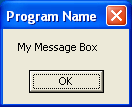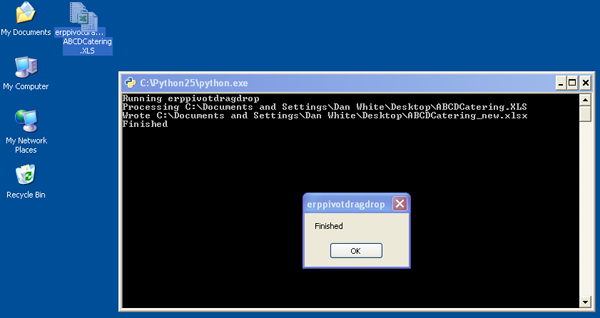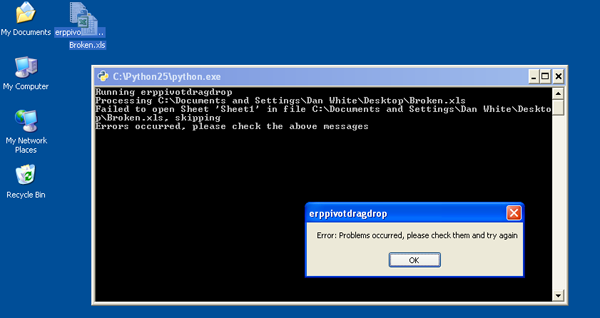A User Friendly Experience | Python Excels¶
Let's be honest for a second, when was the last time you saw a Windows user running something from the command prompt? Well, I do it occasionally, but I can't say I remember seeing a non-IT person using the command prompt recently. So if you're going to offer your users a Windows program, you better give them an icon to click and let them drag stuff onto it. And if something goes wrong, you better have a decent error message. This post will take the Pivot Table generation script developed in the Extending Pivot Table Data post and turn it into a user friendly Windows program with better flexibility and improved user experience.
The scripts developed previously could be run at the command line or by double clicking on the icon for the script line this.

![]()
This works because the input file name, ABCDCatering.xls, is hard coded within the script. In the real world, your users have folders containing dozens of randomly named spreadsheets. If a user accidentally provides a corrupt spreadsheet, the program should keep cranking through the other files and let the user recover the damaged file later. The script developed in the last post needs some enhancements to make it more user friendly, including:
- Provide support for multiple randomly named input spreadsheets
- Add some simple message boxes and drag-and-drop support
- Improve the error checking and error recovery to give the user feedback when something goes wrong
To keep things concise, this version of the script only allows the user to run the program by dragging and dropping files onto the program icon. Enhancing the script to also support command line operation is left as an exercise for the user. Let's work through each of the usability issues below:
Multiple File Support
As I mentioned, Windows XP/Vista/7 users typically don't interact with the command prompt. Instead, programs are run by clicking on their icons, either from the desktop, a folder, or the Start menu. A user specifies spreadsheets or document files by opening them in the application or dragging them onto the program icon on the desktop or in the Explorer window. You can also add the file names after the program name at the command prompt if needed.
To process multiple files, the program needs to process command line args, which are already conveniently available in the sys.argv list. Note that the first argument sys.argv[0] is used for the script name. The runexcel function is modified to pass sys.argv to the runexcel function, which loops through each of the input files.
if __name__ == "__main__":
runexcel(sys.argv)
for fname in args[1:]:
# Process spreadsheet files
The for loop wraps the wb = excel.Workbooks.Open(fname) call, the wb.SaveAs() call, and everything in between so each workbook is processed within the loop. After the loop finishes, a check for errors is made. If any errors occurred a warning and message box are issued.
Primitive GUI Support
Adding message boxes and providing basic drag-and-drop support adds a level of familiarity for Windows users. Python supports a large number of GUI frameworks, seehttp://wiki.python.org/moin/GuiProgramming for a comprehensive list. Building a complete graphic interface for this script is beyond the scope of this article, and isn't really necessary anyway. Instead, you can add support for simple message boxes using the MessageBoxA function built into Windows. The basic pattern for calling a message box using this technique is to import ctypes and call windll.user32.MessageBoxA:
from ctypes import *
windll.user32.MessageBoxA(None,"My Message Box","Program Name",0)
This simple code produces a message box with the text "My Message Box", an OK button, and "Program Name" as the top banner. When Python encounters windll.user32.MessageBoxA(), program execution pauses until the user clicks the OK button.

Improve Error Checking
Lots of problems can happen when reading user spreadsheet data. The user can forget to specify an input file. They could try to have the script read a Word document or other non-spreadsheet file type. The spreadsheet might be corrupted. You need to bulletproof your script and guard against potential issues, both known and unknown.
Previous versions of the script made limited use of the try/except pattern to catch errors.
try:
wb = excel.Workbooks.Open('ABCDCatering.xls')
except:
print "Failed to open spreadsheet ABCDCatering.xls"
sys.exit(1)
erppivotdragdrop.py makes more liberal use of try/except, wrapping more of the program code in the try block. If an error occurs, it can be handled more cleanly with nice warning messages. The downside of using try/except is that you lose the traceback message telling you where the error occurred. To get this information back, use the traceback module and the traceback.print_exc()function. One usage is to call traceback.print_exc() in the except block like this:
import traceback
try:
a = 1/0
except:
# Do error recovery
traceback.print_exc()
Now exceptions are caught, handled, and a more detailed traceback is still available.
Running the script
Let's test out the script. First, copy the script to the desktop and drag the ABCDCatering.xls spreadsheet onto the icon. Python starts running in the command window and begins processing the file you dragged. If everything ran successfully, you'll see a series of messages and the "Finished" message box.

If a problem occurred, a message is displayed in the command window. At the end of the run, the message box is displayed letting you know that something bad happened and that you should review the error messages.

The completed script is too long to reproduce here, please go here to view the complete script.
Prerequisites
Python (refer to http://www.python.org)
Win32 Python module (refer to http://sourceforge.net/projects/pywin32)
Microsoft Excel (refer to http://office.microsoft.com/excel)
Source Files and Scripts
Source for the program erppivotextended.py and spreadsheet file ABCDCatering.xls are available at http://github.com/pythonexcels/examples
Thanks — Dan